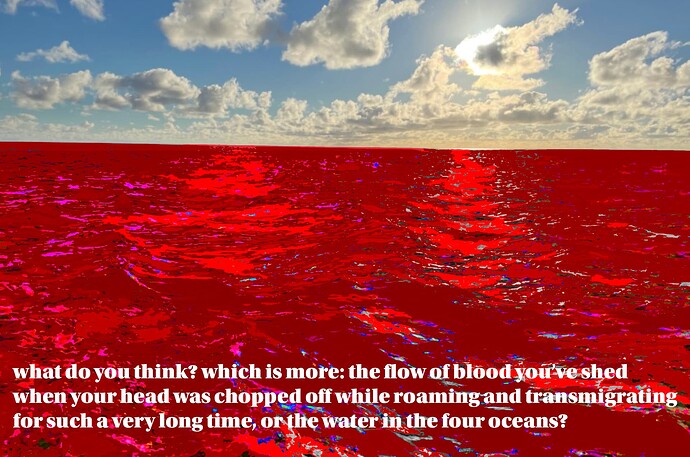Apart from the 32 parts of the body, and asubha, i found two images that the Buddha gave to be very useful for turning the mind away from sense desire. Specifically the ocean of blood, and the mountain of bones, which are mentioned in sn15.13, and sn15.10, and elsewhere. It kind of overlaps with the 32 parts and asubha.
Could one call this a meditation on “transmigration has no known beginning”?
And he said that “this is quite enough for you to become disillusioned, dispassionate, and freed regarding all conditions.” I am reading freed from all conditions meaning entering nibbana.
I assume that this theme has been developed in depth by meditation masters and scholars and i would be very grateful for receiving further references (essays, books), and thoughts on this subject, thank you.
I have made this illustration below to develop the idea, and it seems that painting the picture in one’s mind in detail is indeed helpful.
One needs to practice ‘right view’ (i.e. ‘vipassana’ meditation technique) for viraga ‘fading away of desire’, according to SN/SA suttas; see p. 53:
Pages 52-4 from The Fundamental Teachings of Early Buddhism Choong Mun-keat 2000.pdf (226.0 KB)
Detachment/dispassion is a specific stage:
“enough to become disenchanted with all fabrications, enough to become dispassionate, enough to be released.”
Samyutta Nikaya 15.13
The Buddha is referring to steps in a process, and these are found in practice context in the fourth tetrad of the Anapanasati sutta.
Also: Anguttara Nikaya 10.60
The overview of Samyutta Nikaya 15.13 is the Buddha is addressing less experienced monks, so teaching at the level of Anapanasati. The strong imagery is to impress upon the inexperienced mind the repetitive cycles of samsara. Such imagery would not be used at the arahant level.
The abandoning of greed and distress and release of attachment is a gradual process referred to in all four tetrads. The images in Samyutta Nikaya 15.13 are to convey the separation of ‘the world’ as distinct from ‘the unconditioned’.
" On whatever occasion a monk trains himself, ‘I will breathe in…&…out focusing on inconstancy’; trains himself, ‘I will breathe in…&…out focusing on dispassion’; trains himself, ‘I will breathe in…&…out focusing on cessation’; trains himself, ‘I will breathe in…&…out focusing on relinquishment’: On that occasion the monk remains focused on mental qualities in & of themselves — ardent, alert, & mindful — putting aside greed & distress with reference to the world. He who sees with discernment the abandoning of greed & distress…"
Majjhima Nikaya 118, part B
